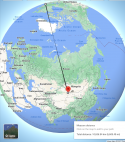What I meant was a straight line across the surface of the globe, not on a map. It should always look straight, this is from Hami to NYC:the shortest path between 2 points on a map is a great circle which does NOT look like a line in a 2-D projection of the world.
Here's a google maps link to show you the shortest path along the great circle between two random points on the map, which may or may not be relevant: Hotan, Xinjiang, China and NYC.
Note the trajectory heading over western Russia, Atlantic and Eastern Canada like I said. Notice total length of trajectory is ~10000 km, well within range of certain rockets.
It has nothing to do with Alaska or the Pacific. It is often shorter to shoot westwards, people only have a mental bias towards shooting east because of how maps are laid out and because that's where other allies of certain countries are located.
If the path doesn't show up just use the measure distance tool on your own.

So there's only ever 2 trajectories an ICBM can approach the same target from a given launch point? The shortest distance one like above or the exact opposite direction around the globe (if it's a FOBS), where both the direction of launch and direction of approach would differ by 180 degrees exactly. So it's not possible for the ICBM to approach a target from any other than these 2 directions. For example if the missile launched from Hami wants to travel over Eastern Russia/Alaska it would be launched on an angle maybe 30 or 40 deg more eastward, but then it would have to turn left over halfway through flight over Alaska but that's impossible since it's no longer being boosted at that point. And I don't think it's possible for a rocket to make such a large turn even if it were (not enough fuel)?
Last edited:
